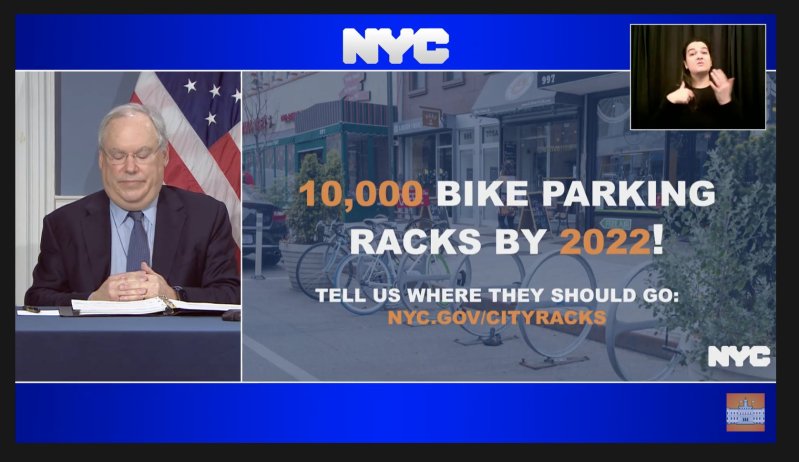How in the World is DOT Going to Install 10,000 Bike Racks in Two Years?

They just let people promise anything these days.
Mayor de Blasio and new Department of Transportation Commissioner Hank Gutman said on Wednesday that DOT would install 10,000 bike racks by the end of 2022 — which, if achieved, would be 3,500 bike racks per year above the annual goal of 1,500 bike racks that DOT hasn’t been able to consistently reach in the de Blasio years.
In the last fiscal year (July 1, 2019 to June 30, 2020), the city installed just 647 bike racks. Even accounting for the pandemic, the shortfall was on trend for the DOT; the DOT has been able to reach the 1,500 rack goal just three times in the de Blasio years:
- Fiscal year 2015: 2,408 bike racks
- FY2017: 2,018
- FY2019: 1,642
Those numbers are far lower than the 3,541 bike racks DOT installed in FY2013 and the 3,656 bike racks installed in FY 2014 (see chart in the tweet below).
We track #bikenyc rack installations via the Mayor’s Management Report, just released for fiscal 2020. We expected installations to drop (FY is July-June). Let’s hope this is the all time trough year.@NYC_DOT’s stated install target is 1,500/year, which is much, much too low pic.twitter.com/nL5QekMHqh
— Bike New York (@bikenewyork) September 18, 2020
As advocates have previously pointed out, even the target of 1,500 bike racks per year leaves New York woefully short on bike parking spaces, creating just 17.8 bike racks per 100,000 people. Second-rate backwater cities like “San Francisco” and “Seattle” manage to create hundreds of bike racks for their smaller populations.

Even as the city has installed more protected bike lane miles every year, it hasn’t paired that with any kind of ramped up bike parking effort. The city has failed to build secure bike parking of its own and failed to work with privately run secure bike parking companies as well. The result means that there’s only one bike parking spot for every 116 bikes in the city, according to a report from Transportation Alternatives.

Outside of the frequently missed bike rack target, the new DOT commish is going to have to figure out how to speed up the bike corral program. That effort, which is supposed to replace a street space that can fit one car with multiple bike racks, began in 2011. But there are still only 66 bike corrals in the entire city, because the program relies on outside maintenance partners. Each corral also requires a community board to get involved, which the recent installation of a bike corral outside a Whole Foods showed, can sometimes result in hysterical reactions like, “This will kill a child.”
Despite the questions around how the city will install 233 percent more bike racks than it has previously promised, City Hall spokesman Mitch Schwartz promised that the administration would “play offense” instead of commit offenses against city cyclists, and specifically touted the bike parking installed outside Elmhurst Hospital in Queens and Maimonides Hospital in Brooklyn.
Advocates greeted the promise with enthusiasm, albeit tempered by reality.
“This sets a new bar, and it’s really badly needed,” said Bike New York Advocacy Director Jon Orcutt. “Hopefully this is simple and straightforward: the numbers will go up because someone is going to work on it.”
Orcutt predicted that the agency will deliver on its promise, especially given the years of bruising coverage of the DOT’s failures.
“Somebody has to care about this, and we hadn’t been beating them up on it for the last three years, no one would have,” he said.
Still, there’s work to do to ensure that the parking gets placed fairly. Gutman told the public he was seeking their input when it came to where the bike racks would go, but Transportation Alternatives organizer Erwin Figueroa pointed out that the outreach for the racks must go beyond just sending people to the city’s bike parking website, which is entirely in English.
There needs to be direct outreach done, in the community's native languages, to delivery workers, community centers, places of worship, and other community institutions to ensure racks are distributed equitably.
— Erwin Figueroa (@TransitErwin) February 3, 2021
A map of the CityRack locations shows that the city will have to focus outside of Manhattan if it wants to be more fair, as gaps start to show the further away things get from the big island (see maps below). In addition, a list of the city’s bike corrals shows that the vast majority of the lockup spots are in Brooklyn and Manhattan. Seven corrals are in Queens, and only one each exists in the Bronx and Staten Island, respectively.







